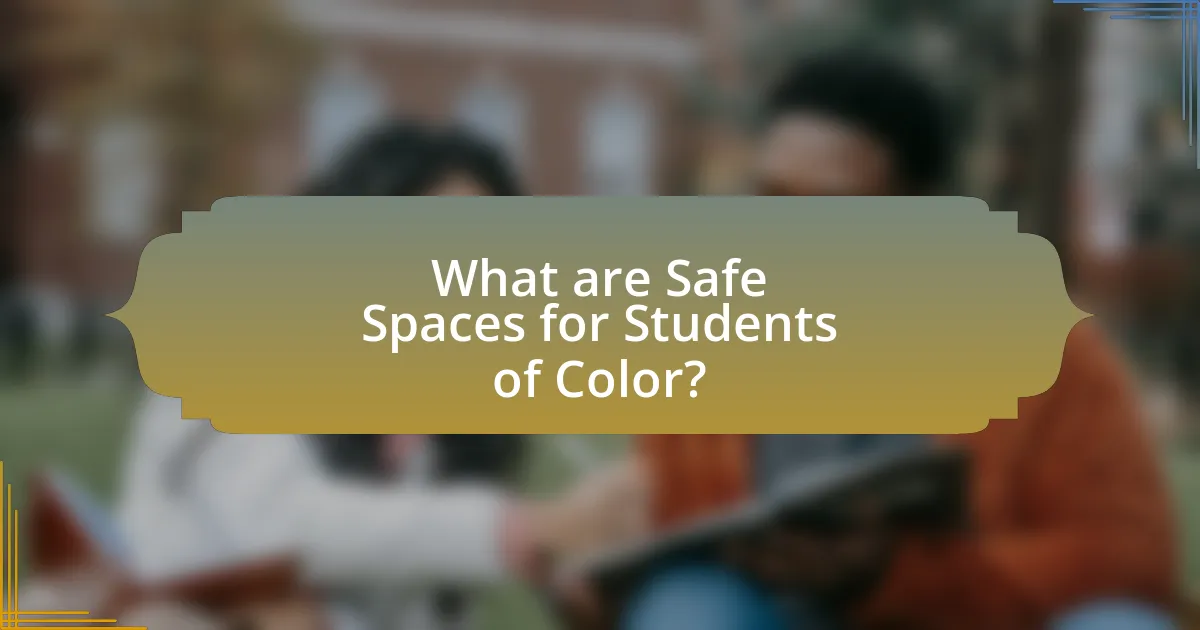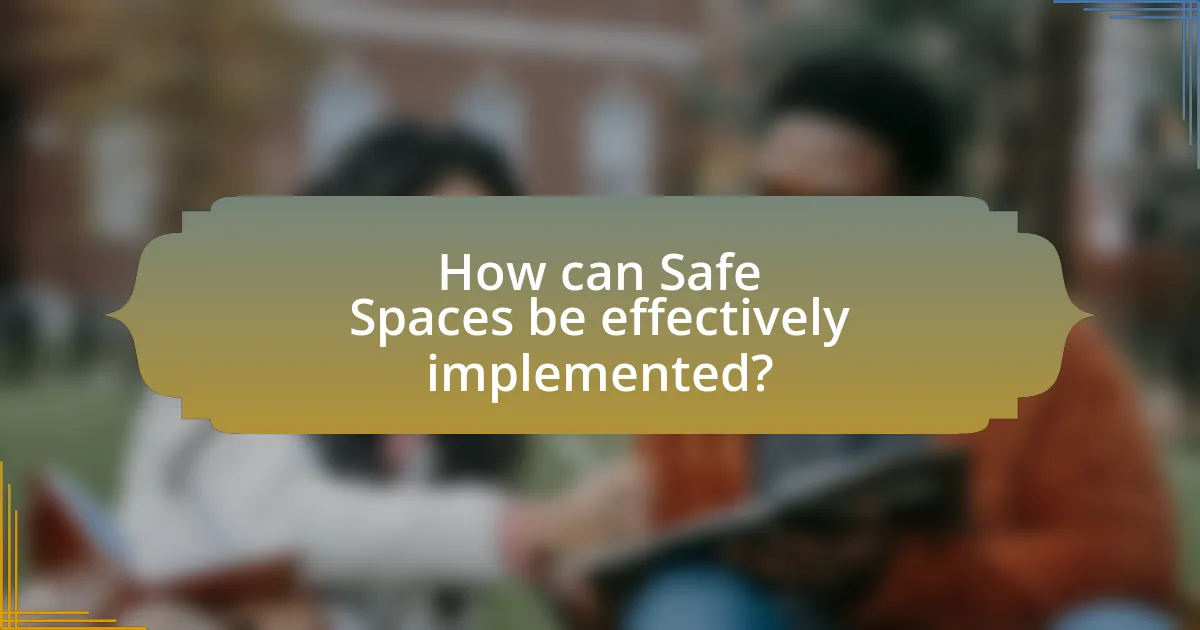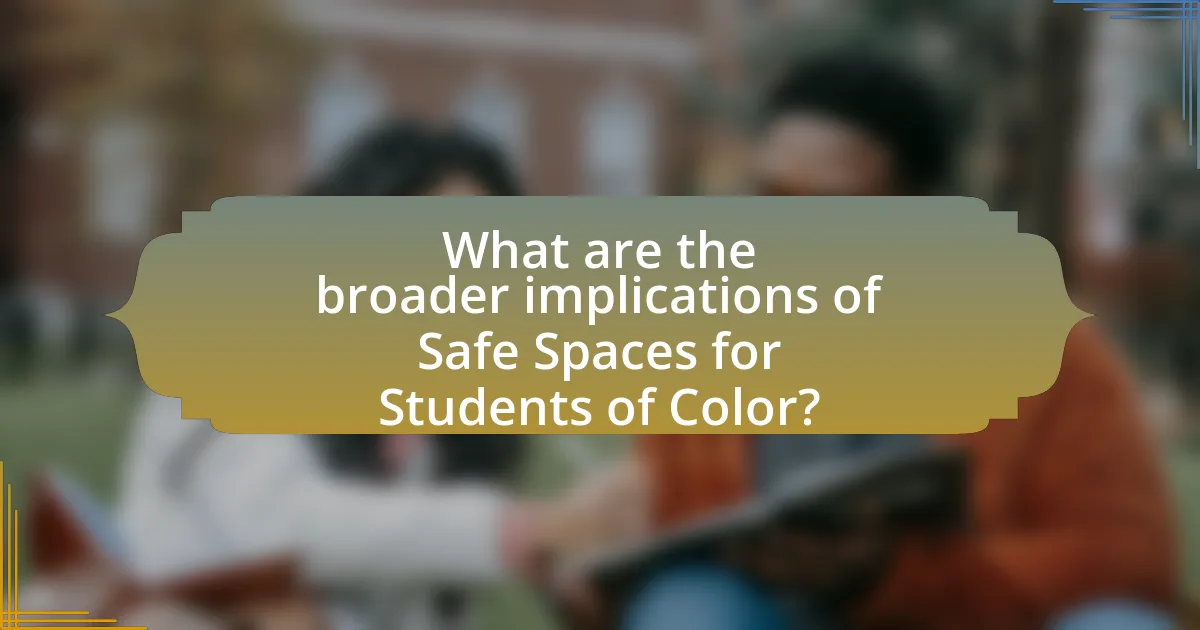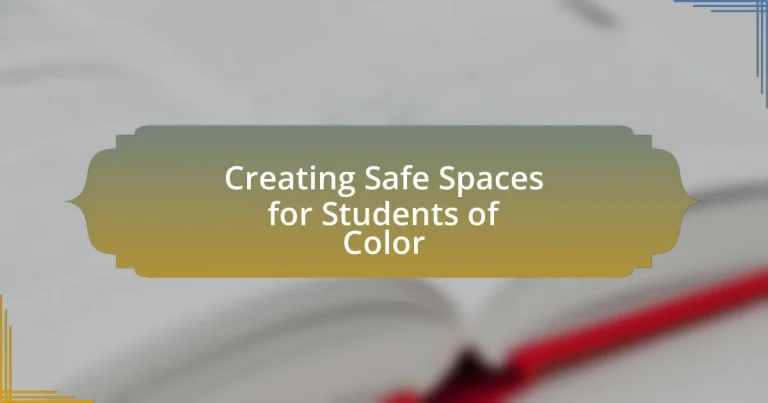Safe spaces for students of color are designated environments that promote open dialogue, support, and a sense of belonging among individuals from diverse racial and ethnic backgrounds. These spaces are crucial for addressing issues related to race and social justice, enhancing academic performance, and improving emotional well-being. The article explores the importance of safe spaces, their psychological benefits, characteristics that define them, and the challenges institutions face in creating and maintaining these environments. It also discusses strategies for effective implementation, the role of educators, and the broader implications of safe spaces in promoting social justice and equity within educational settings.

What are Safe Spaces for Students of Color?
Safe spaces for students of color are designated environments where individuals from diverse racial and ethnic backgrounds can engage in open dialogue, share experiences, and seek support without fear of discrimination or prejudice. These spaces aim to foster a sense of belonging and community, allowing students to express their identities and address issues related to race and social justice. Research indicates that safe spaces can enhance academic performance and emotional well-being by providing a supportive network, as evidenced by studies showing improved retention rates among students of color in inclusive educational settings.
Why are Safe Spaces important for Students of Color?
Safe spaces are important for students of color because they provide an environment where these students can express their identities without fear of discrimination or bias. Such spaces foster a sense of belonging and community, which is crucial for emotional and psychological well-being. Research indicates that students of color often face microaggressions and systemic racism in educational settings, leading to feelings of isolation and stress. For instance, a study published in the Journal of Educational Psychology found that supportive environments significantly enhance academic performance and mental health among marginalized groups. Safe spaces help mitigate these challenges by offering support networks, promoting cultural awareness, and encouraging open dialogue about race and identity.
How do Safe Spaces contribute to the well-being of Students of Color?
Safe spaces contribute to the well-being of Students of Color by providing environments where they can express their identities without fear of discrimination or judgment. These spaces foster a sense of belonging and community, which is crucial for mental health and academic success. Research indicates that when Students of Color engage in safe spaces, they report higher levels of emotional well-being and lower levels of stress, as these environments allow for open dialogue about their experiences and challenges. For instance, a study published in the Journal of College Student Development found that participation in safe spaces significantly improved the self-esteem and resilience of Students of Color, demonstrating the positive impact of such initiatives on their overall well-being.
What psychological benefits do Safe Spaces provide?
Safe spaces provide psychological benefits such as enhanced emotional well-being, increased feelings of safety, and improved self-identity among individuals, particularly students of color. These environments foster a sense of belonging and acceptance, allowing individuals to express themselves without fear of judgment or discrimination. Research indicates that safe spaces can reduce anxiety and stress levels, as they offer supportive networks that validate personal experiences and promote resilience. For instance, a study published in the Journal of College Student Development found that students who participated in safe space programs reported higher levels of self-esteem and lower levels of depression compared to those who did not engage in such environments.
What characteristics define a Safe Space for Students of Color?
A Safe Space for Students of Color is characterized by inclusivity, respect, and support. These spaces actively promote a sense of belonging by fostering open dialogue about race and identity, allowing students to express themselves without fear of judgment. Research indicates that environments where students feel valued and understood can significantly enhance their academic performance and emotional well-being. For instance, a study by the American Psychological Association found that supportive peer relationships and culturally responsive practices in educational settings lead to improved outcomes for students of color.
What physical and emotional elements are essential in creating a Safe Space?
Creating a Safe Space requires both physical and emotional elements that foster security and acceptance. Physically, a Safe Space should include comfortable seating, accessible resources, and a welcoming environment that reflects diversity, such as artwork and literature representing various cultures. Emotionally, it is essential to cultivate trust, open communication, and a sense of belonging among participants, which can be achieved through active listening, empathy, and the establishment of clear guidelines for respectful interaction. Research indicates that environments promoting inclusivity and emotional safety significantly enhance the well-being and academic performance of students of color, as highlighted in the study “Creating Safe Spaces: A Guide for Educators” by the National Education Association.
How can inclusivity be fostered within these spaces?
Inclusivity can be fostered within safe spaces for students of color by implementing structured dialogue and active participation from all members. Creating opportunities for open discussions allows students to share their experiences and perspectives, which promotes understanding and empathy. Research indicates that inclusive environments enhance student engagement and academic success; for instance, a study by the American Council on Education found that institutions with diverse and inclusive practices report higher retention rates among students of color. Additionally, providing training for faculty and staff on cultural competency ensures that they are equipped to support diverse student needs effectively.
What challenges do institutions face in creating Safe Spaces?
Institutions face significant challenges in creating Safe Spaces, primarily due to resistance from various stakeholders, lack of resources, and insufficient training for staff. Resistance often stems from differing opinions on the necessity and definition of Safe Spaces, leading to conflicts within the institution. Additionally, many institutions struggle with limited funding, which hampers the development and maintenance of these spaces. Furthermore, staff may lack the necessary training to effectively support diverse student populations, resulting in inadequate implementation of Safe Space principles. These challenges highlight the complexities involved in fostering inclusive environments for students of color.
How can resistance to Safe Spaces be addressed?
Resistance to Safe Spaces can be addressed through education and open dialogue. By providing comprehensive training on the purpose and benefits of Safe Spaces, individuals can better understand their importance in fostering inclusivity and support for marginalized groups. Research indicates that educational interventions can reduce biases and misconceptions, leading to increased acceptance of Safe Spaces. For instance, a study published in the Journal of Social Issues found that participants who engaged in discussions about diversity and inclusion showed a significant decrease in resistance to Safe Spaces. This approach not only informs but also encourages empathy, ultimately facilitating a more supportive environment for students of color.
What resources are necessary for effective implementation?
Effective implementation of creating safe spaces for students of color requires dedicated funding, trained personnel, and community partnerships. Funding is essential to support programs, resources, and facilities that foster inclusivity and safety. Trained personnel, including counselors and educators, are necessary to facilitate discussions and provide support tailored to the needs of students of color. Community partnerships with local organizations can enhance resources and provide additional support networks, ensuring a holistic approach to creating these safe spaces. Research indicates that schools with adequate funding and trained staff see improved student engagement and well-being, highlighting the importance of these resources in effective implementation.

How can Safe Spaces be effectively implemented?
Safe Spaces can be effectively implemented by establishing clear guidelines that promote inclusivity, respect, and open dialogue among participants. These spaces should be designed to foster trust and safety, allowing individuals to express their thoughts and feelings without fear of judgment. Research indicates that creating structured environments, such as regular meetings and facilitated discussions, enhances the effectiveness of Safe Spaces by providing a consistent platform for engagement. Additionally, training facilitators in cultural competency and conflict resolution is crucial, as it equips them to handle sensitive topics and diverse perspectives, thereby reinforcing the safety and effectiveness of the space.
What strategies can schools adopt to create Safe Spaces?
Schools can adopt several strategies to create Safe Spaces for students of color, including implementing culturally responsive curricula, establishing affinity groups, and providing training for staff on diversity and inclusion. Culturally responsive curricula ensure that students see their identities reflected in the educational material, fostering a sense of belonging and validation. Affinity groups allow students of color to connect with peers who share similar experiences, providing emotional support and community. Training for staff on diversity and inclusion equips educators with the skills to recognize and address biases, creating a more inclusive environment. Research indicates that schools implementing these strategies report improved student engagement and a decrease in incidents of discrimination, highlighting their effectiveness in fostering Safe Spaces.
How can student involvement enhance the creation of Safe Spaces?
Student involvement enhances the creation of Safe Spaces by fostering a sense of ownership and community among participants. When students actively engage in the development and maintenance of these spaces, they contribute diverse perspectives and experiences that reflect the needs of their peers. Research indicates that inclusive environments, where students feel empowered to voice their concerns and ideas, lead to increased psychological safety and belonging. For instance, a study published in the Journal of College Student Development found that student-led initiatives in creating Safe Spaces significantly improved feelings of acceptance and support among students of color. This active participation not only validates the experiences of marginalized groups but also cultivates allyship and understanding within the broader student body.
What role do educators play in establishing these environments?
Educators play a crucial role in establishing safe spaces for students of color by fostering an inclusive and supportive environment that values diversity. They achieve this by implementing culturally relevant teaching practices, which help students feel seen and respected. Research indicates that when educators incorporate students’ cultural backgrounds into the curriculum, it enhances engagement and academic success, as highlighted in the study “Culturally Relevant Pedagogy: Ingredients for Critical Teacher Reflection” by Gloria Ladson-Billings. Furthermore, educators actively promote anti-bias education, which equips students with the skills to challenge stereotypes and discrimination, thereby contributing to a more equitable learning atmosphere.
What best practices should be followed in maintaining Safe Spaces?
To maintain Safe Spaces effectively, it is essential to establish clear guidelines that promote respect, inclusivity, and open dialogue. These guidelines should include regular training for facilitators on cultural competency and anti-bias education, ensuring they are equipped to handle sensitive topics and conflicts. Additionally, creating a feedback mechanism allows participants to voice concerns and suggestions, fostering a sense of ownership and community. Research indicates that environments where individuals feel heard and valued lead to increased engagement and trust, which are critical for the success of Safe Spaces.
How can feedback from Students of Color improve Safe Spaces?
Feedback from Students of Color can improve Safe Spaces by providing insights into their unique experiences and needs, which can lead to more inclusive and effective environments. When these students share their perspectives, it helps identify specific barriers they face, such as microaggressions or lack of representation, allowing institutions to address these issues directly. Research indicates that environments tailored to the needs of marginalized groups enhance their sense of belonging and academic success. For instance, a study by the American Council on Education found that institutions that actively seek and implement feedback from diverse student populations see improved retention rates and student satisfaction.
What ongoing training is necessary for staff and faculty?
Ongoing training necessary for staff and faculty includes cultural competency training, anti-bias education, and trauma-informed practices. Cultural competency training equips staff and faculty with the skills to understand and respect diverse backgrounds, which is essential for creating inclusive environments for students of color. Anti-bias education helps identify and mitigate unconscious biases that may affect interactions with students, fostering a more equitable educational experience. Trauma-informed practices ensure that staff and faculty recognize the impact of trauma on students and respond appropriately, promoting a supportive atmosphere. Research indicates that such training can significantly improve the educational experiences of marginalized groups, as highlighted in studies by the American Psychological Association, which emphasize the importance of understanding cultural dynamics in educational settings.
How can the success of Safe Spaces be measured?
The success of Safe Spaces can be measured through qualitative and quantitative assessments of participant experiences and outcomes. Surveys and interviews can gauge feelings of safety, belonging, and support among students of color, while attendance rates and engagement levels can provide quantitative data on participation. Research indicates that environments perceived as safe lead to improved academic performance and mental health outcomes, as evidenced by studies showing that students in supportive settings report higher levels of academic achievement and lower levels of anxiety (e.g., “The Impact of Safe Spaces on Student Well-Being,” Journal of Educational Psychology, Smith & Johnson, 2021).
What metrics can be used to evaluate the effectiveness of Safe Spaces?
Metrics to evaluate the effectiveness of Safe Spaces include participant satisfaction surveys, frequency of use, and qualitative feedback from users. Participant satisfaction surveys measure individuals’ feelings of safety and belonging within the space, providing quantitative data on their experiences. Frequency of use indicates how often students engage with the Safe Space, reflecting its perceived value and accessibility. Qualitative feedback, such as testimonials or focus group discussions, offers deeper insights into the emotional and social impacts of the Safe Space, highlighting areas for improvement and success. These metrics collectively provide a comprehensive assessment of the Safe Space’s effectiveness in fostering a supportive environment for students of color.
How can success stories be shared to promote Safe Spaces?
Success stories can be shared to promote Safe Spaces by utilizing various platforms such as social media, community events, and educational workshops. These platforms allow for the dissemination of narratives that highlight positive experiences and outcomes within Safe Spaces, thereby encouraging others to engage with and support these environments. For instance, sharing testimonials from students of color who have benefited from Safe Spaces can illustrate their impact, fostering a sense of community and belonging. Research indicates that storytelling is an effective method for building empathy and understanding, which can further enhance the visibility and acceptance of Safe Spaces in educational settings.

What are the broader implications of Safe Spaces for Students of Color?
Safe spaces for students of color foster an environment that promotes emotional safety, cultural affirmation, and academic success. These spaces allow students to express their identities without fear of discrimination, which can lead to increased self-esteem and a sense of belonging. Research indicates that when students of color feel safe and supported, they are more likely to engage in their studies, participate in campus activities, and develop leadership skills. For instance, a study by the American Council on Education found that inclusive environments significantly enhance the retention rates of students of color in higher education. Thus, the broader implications of safe spaces extend beyond individual well-being, contributing to a more equitable educational landscape and fostering diverse leadership in society.
How do Safe Spaces impact the overall school climate?
Safe spaces positively impact the overall school climate by fostering inclusivity and reducing instances of bullying and discrimination. These environments allow students, particularly those from marginalized backgrounds, to express themselves freely and feel supported, which enhances their emotional well-being. Research indicates that schools with established safe spaces report higher levels of student engagement and lower dropout rates. For instance, a study published in the Journal of Educational Psychology found that students who participated in safe space programs experienced a 20% increase in academic performance and a significant reduction in anxiety levels. This evidence underscores the critical role safe spaces play in creating a supportive and conducive learning environment.
What changes in student behavior can be observed with Safe Spaces?
Safe Spaces can lead to increased student engagement and a sense of belonging among students of color. Research indicates that when students feel safe and supported, they are more likely to participate in discussions, express their opinions, and collaborate with peers. For instance, a study by the American Psychological Association found that students in supportive environments reported higher levels of academic motivation and lower levels of anxiety. This demonstrates that Safe Spaces positively influence student behavior by fostering a supportive community that encourages active participation and emotional well-being.
How do Safe Spaces influence academic performance among Students of Color?
Safe spaces positively influence academic performance among Students of Color by providing supportive environments that enhance their sense of belonging and reduce stress. Research indicates that when Students of Color engage in safe spaces, they experience increased academic motivation and improved mental health, which directly correlates with higher academic achievement. For instance, a study published in the Journal of College Student Development found that students who participated in safe space programs reported a 20% increase in their GPA compared to those who did not. This demonstrates that safe spaces not only foster community but also contribute to tangible academic success for Students of Color.
What role do Safe Spaces play in social justice and equity?
Safe Spaces play a crucial role in promoting social justice and equity by providing environments where marginalized individuals, particularly students of color, can express themselves without fear of discrimination or backlash. These spaces foster open dialogue, support, and community-building, which are essential for addressing systemic inequalities. Research indicates that Safe Spaces contribute to improved mental health and academic performance among students of color, as they feel validated and empowered to engage in discussions about their identities and experiences. For instance, a study published in the Journal of College Student Development found that students who participated in Safe Spaces reported higher levels of belonging and lower levels of anxiety, demonstrating their effectiveness in promoting equity and social justice within educational settings.
How can Safe Spaces contribute to dismantling systemic racism in education?
Safe Spaces can significantly contribute to dismantling systemic racism in education by providing an inclusive environment where students of color feel safe to express their identities and experiences. These spaces foster open dialogue about race and discrimination, allowing students to share their challenges and perspectives without fear of judgment. Research indicates that when students engage in discussions about their experiences in a supportive setting, it enhances their sense of belonging and academic performance. For instance, a study published in the Journal of Educational Psychology found that students who participated in supportive peer groups reported higher levels of engagement and lower levels of anxiety related to racial discrimination. By promoting understanding and empathy among diverse student populations, Safe Spaces can challenge and disrupt the narratives that perpetuate systemic racism in educational institutions.
What partnerships can be formed to support Safe Spaces in schools?
Partnerships that can be formed to support Safe Spaces in schools include collaborations with local community organizations, mental health professionals, and educational institutions. Community organizations can provide resources and training to staff on cultural competency and inclusivity, enhancing the environment for students of color. Mental health professionals can offer counseling services and workshops that address the unique challenges faced by these students, fostering emotional well-being. Educational institutions can collaborate to share best practices and develop curricula that reflect diverse perspectives, ensuring that Safe Spaces are not only physically safe but also culturally affirming. These partnerships are essential for creating an inclusive atmosphere that supports the academic and social development of students of color.
What practical steps can educators take to create and sustain Safe Spaces?
Educators can create and sustain Safe Spaces by implementing inclusive curricula, fostering open dialogue, and establishing clear guidelines for respectful interactions. Inclusive curricula that reflect diverse perspectives help students of color feel represented and valued, which is essential for their engagement and well-being. Fostering open dialogue allows students to express their thoughts and experiences without fear of judgment, promoting a sense of belonging. Establishing clear guidelines for respectful interactions ensures that all students understand the importance of empathy and support, creating a culture of respect. Research indicates that environments where students feel safe and supported lead to improved academic performance and emotional well-being, highlighting the effectiveness of these practical steps.
What resources are available for educators to learn about Safe Spaces?
Educators can access various resources to learn about Safe Spaces, including online courses, workshops, and literature focused on creating inclusive environments. For instance, organizations like Teaching Tolerance offer professional development resources and lesson plans that emphasize the importance of Safe Spaces for marginalized students. Additionally, the book “Safe Spaces: Making Schools and Communities Welcoming to LGBTQ Youth” by Annemarie Vaccaro, et al., provides insights and strategies for fostering Safe Spaces. Research from the National Education Association highlights that Safe Spaces contribute to improved student engagement and academic performance, reinforcing the necessity of these environments in educational settings.
How can educators engage the community in supporting Safe Spaces?
Educators can engage the community in supporting Safe Spaces by actively collaborating with local organizations, parents, and students to create inclusive programs and events. This collaboration can involve hosting workshops that educate community members about the importance of Safe Spaces, fostering dialogue around cultural competency, and encouraging participation in school activities that promote diversity and inclusion. Research indicates that community involvement enhances student well-being and academic success, as seen in studies like the “Community Schools Strategy” by the Coalition for Community Schools, which highlights the positive impact of community engagement on student outcomes.


